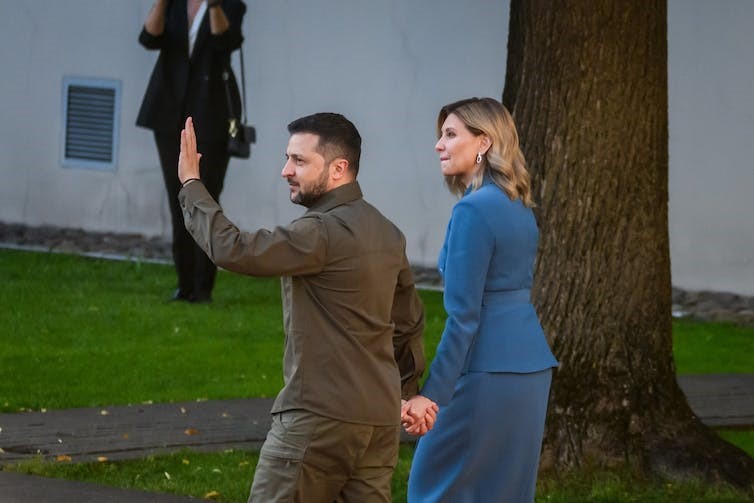Arweiniodd ymddygiad ymosodol Sofietaidd at sefydlu cynghrair NATO - dyma pam fod hynny'n bwysig nawr

Mae'r Arlywydd Volodymyr Zelensky a'i wraig Olena Zelenska. Gints Ivuskans/Shutterstock
12 Gorffennaf 2023
Wrth i arweinwyr NATO gwrdd i drafod dyfodol Wcrain o fewn y gynghrair, mae Dr Jan Ruzicka a Dr R Gerald Hughes o'r Adran Gwleidyddiaeth Ryngwladol yn ysgrifennu yn The Conversationam sut mae'r trafodaethau presennol yn cymharu â dechreuad y sefydliad:
As Nato leaders meet in Vilnius, Lithuania, to discuss Ukraine’s future within the alliance, it’s worth considering how the current discussions compare to the beginnings of the organisation.
Military alliances arise from shared interests and values. It remains the case, however, that an external threat is often necessary to crystalise a firm understanding of what these interests and values are. In the absence of a threat, nations in alliance may find it all too easy to become complacent and pursue individual rather than collective goals.
Russia’s continuing war with Ukraine reminds us why Nato was formed in 1949 – in response to Soviet aggression.
The 1948-49 Berlin airlift (when the western allies flew essential supplies into the city while the Soviets blocked other access) became a symbol of the western resolve in the early stages of the cold war.
When the Soviet leader Joseph Stalin launched the Berlin blockade, his goal was not just to cut off the western sectors of the city, but, crucially, to further Soviet interests in Germany. This was in line with a wider objective of establishing communist governments across Europe and fundamentally reshaping the balance of power between the US and the Soviet Union.
With the Soviet Union stirring up trouble all over Europe (and beyond), only a collective security organisation offered a prospect of joint defence. In April 1949, just as the Berlin blockade was nearing its end, the North Atlantic Treaty was signed in Washington DC to keep peace in Europe. Lord Ismay, the first secretary-general of Nato, said the way to achieve this was to “keep the Americans in, the Russians out, and the Germans down”.
Berlin blockade prompts alliance
As with the Berlin blockade and the wider Soviet expansion in the 1940s, today’s alliance must deal with Russia’s aggression on its borders. Consequently, Nato must decide and prepare how to deal with Russia in the years ahead.
The Russian aggression has produced a new wave of Nato membership demands. Finland is already in, having become the alliance’s 31st member earlier this year. Nato secretary-general Jens Stoltenberg confirmed on the first day of the Vilnius summit that Turkey has now withdrawn its objections and so Sweden will soon follow suit.
These two additions are important for the alliance’s north-eastern wing, but they are overshadowed by the question of Ukraine’s future place in Nato.
Some states have spoken forcefully in Ukraine’s favour. UK defence secretary Ben Wallace has argued that Ukraine should be allowed to swiftly join the alliance without hitting some of the usual benchmarks. Poland and the Baltic states (Estonia, Latvia, and Lithuania) have advocated for an unambiguous timeline that would give Ukraine greater certainty about its future Nato prospects. Former chairman of the Nato military committee and current president of the Czech Republic, Petr Pavel, has stressed that a clear prospect of a Nato membership would be “the light at the end of the tunnel” that Ukraine needs to be able to see.
Other members have been more circumspect. Nothing decisive can happen within the alliance without the approval of the US. On the subject of Ukraine, US president Joe Biden said just a few days before the summit: “I don’t think it’s ready for membership in NATO.”
Such a position is perhaps somewhat puzzling given that the US has provided by far the most extensive military assistance to Ukraine. In early July, President Biden ordered and publicly defended sending cluster munitions to Ukraine, despite protests from human rights groups and the US Congress. (Russia has used cluster munitions in the current war).
Breaking Nato
President Biden’s stance will no doubt temper enthusiasm. Indeed, on the first day of the Vilnius summit Ukraine’s president Volodymyr Zelensky criticised the proposed compromise for his country’s path to Nato membership. But this compromise (there’s no timeline for Ukraine’s membership but it will not have to go through some of the usual, time-consuming procedures) also reflects the fact that there are states (such as Hungary) that are currently opposed to Ukraine’s entry into the alliance.
The compromise ensures that Nato does not split over its differences, something that President Biden warned has been Russia’s key objective.
Russia’s war against Ukraine demands a comparable reaction from the west to the one it mounted in the 1940s. The alliance’s 2022 strategic concept document sets out three core tasks of deterrence and defence, crisis prevention and management, and cooperative security. This cannot be achieved without paving the way for new Nato member states, including Ukraine.
Policymakers in Kyiv are surely entitled to ask if there is a clear prospect of it joining the alliance. Until Russia’s revisionist expansionism is stopped, Europe will not be peaceful and secure.
Comparing the situation today with that of 75 years ago a historical paradox becomes apparent – the most decisive impulse to Nato’s existence came from a threat to a people and a territory that were not originally part of the alliance. The Federal Republic of Germany (West Germany) only became a Nato member in May 1955. Today, Ukraine’s resistance has clearly reinvigorated Nato.
A threat to a people and a territory that is not part of it has given the alliance a focus it has not had since the end of the cold war. It is up to Nato members to decide whether they will follow the historical precedent that has served Europe so well.![]()
Mae'r erthygl hon wedi ei hailgyhoeddi o The Conversation dan drwydded Creative Commons. Darllenwch yr erthygl wreiddiol.



